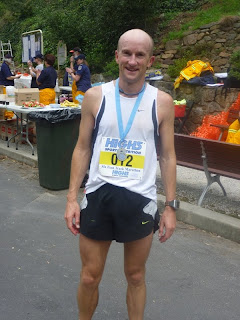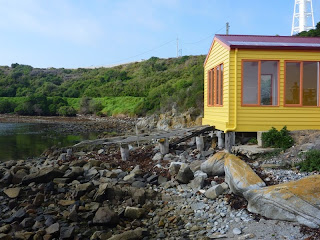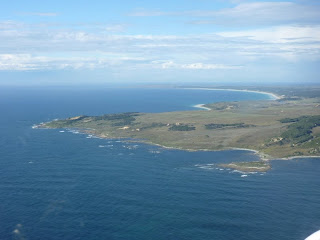Summary
This is a long story...to cut it short, I ran the 45km Six Foot Track marathon on Saturday. It's an epic hard trail run up, down, through and over the Blue Mountains in NSW. A fantastic event, I came 4th overall in 3:31:14hr. (Some photos at bottom.)
Long Story
Several people had warned me about the last 2km of the race, a steep, rocky downhill section to the finish line; treacherous running at any time let alone after the 43km we'd already travelled over mountains, through rivers, over fences, around mud pits and more. After that amount of running the downhill hammering on your legs - like this final 2km - is like a cricket bat whacking your quads with each step. But for me this stretch was welcome relief - my legs were so sore and tired that each uphill literally brought tears to my eyes. Instead I almost had tears of joy - I was in 4th place and about to finish my first Six Foot Track marathon.
The Six Foot Track (SFT) is a 45km footpath stretching across the Blue Mountains from The Explorer's Marked Tree, near Katoomba to Jenolan Caves. The marathon started in 1984 and follows the length of the entire footpath. It is Australia's 5th largest marathon and by far the largest 100% off-road running event. I first read about it a few years ago in a magazine, which piqued my interest enough to enter early on 1st December last year - the 850 spots filled up in 10 hours. It's a popular and iconic event, particularly in NSW / ACT.
This race would be unlike anything else I've ever done. The race information - and anecdotal reports - tell of steep downhill sections (including slippery, rocky steps), chest deep river crossings, narrow single-track paths, stiles (basically, mini step-ladders over fences), rocks and more rocks, and not to mention long, steep uphill sections...with only the final 10m being on bitumen. However and wherever I prepared, the entire course would still be a mystery until race day...how steep actually are the hills? How rough are the tracks? The prospect of what was ahead excited me no end.
Race weekend arrived (it was a Saturday race) and I was joined by Andrea as we made the journey by plane, then car for the 2hrs or so drive up to Katoomba, which is perhaps better known for it's proximity to the 3 Sisters rock formation which juts out into the vast valley which drops dramatically, and spectacularly, from the edge of the town. We then went on to see the race start, adjacent to the Explorer's Marked Tree, which is only a small dirt clearing with a rough and rugged pathway disappearing into the bush...the Six Foot Track. Although the forecast was good, recent heavy rains had left the track very wet, slippery and eroded in places, with plenty of water in the rivers.
Andrea and I shared accommodation with some Sydney-siders...Matt (who generously drove us up), Rogerio (Rog), Guillaume (Will), Marc and Deb - only the boys were running. Race morning was dark and cold, and everyone milled around the dirt start area variously keeping warm, talking, drinking coffee or enjoying the free breakfast served up by the Rural Fire Service (RFS) whose volunteer efforts for the event were extraordinary.
The Coolrunning on-line forum had a section dedicated to the SFT, with all range of topics including one about the contenders with various people posting their predictions and best bets. Somehow I managed a mention but in reality, as a novice, was a very long shot. Nonetheless, I was seeded #10 and standing on the start line was fascinated to see the different shapes and sizes of the highly fancied runners, in particular the hot favourite Andrew Lee (2nd last year and perennial top-3) who is a ball of muscle, and Alex Matthews (3rd last year) who is thinner than a rake handle, with legs up to his arm-pits. I just wanted to fit in with the crowd and thought top-10 would be a great debut.
The 15m wide start line narrows to about 3m wide in the first 25m, and heads steeply downhill over rough, rocky and slippery ground before reaching the steps after about 500m. My tale of woe started with the downhill section...I was cautious and tentative compared to the gazelles who floated over the rocks around me. At least I stayed on my feet and was in about 14th place reaching the steps, even more scary without any handrails, wet and slippery, very uneven and with a pack of anxious runners breathing down my neck from behind.
Soon we were off the steps and onto rough rocks, then onto dirt track, then a dirt road as we ran along the Megalong Valley through the 4-8km stage, which included several stiles over fences. I'd moved past a number of others but not sure where I was placed until passing 2 more guys who said I was into 4th place - wow, this was way better than I expected. As we turned a corner I could see 1st to 3rd within a minute ahead.
The terrain varied a lot, from the dirt road then into almost farm land on sheep trails, through ditches, gully's, over tree roots, rocks, boulders and pot holes - sometime all those obstacles at the same time!! It required careful concentration...I'd had pre-race nightmares of tripping and going head long into a rock or something. We started passing people who began 1 hour earlier, each who gave some encouragement...which I responded in turn. It was a fantastic stretch of 4-5km down a single track, dodging more obstacles, as we headed to the river crossing - it was exhilarating running.
Cox's river is the first landmark of the course, at 15.5km (1:04hr), and has a rope across it to help you through the chest-deep water. The race had closed up with the top-4 all in the water at the same time - I was right in the midst of it!!! Out of the river the road heads up the first major climb of the day to Mini-Mini Saddle. Hard man and great runner Dave Criniti ran ahead, followed by Andrew Lee then me in 3rd...the fourth runner disappeared out of sight behind us. It is a damn steep hill, and just burned and strained every muscle in my legs...and I couldn’t see the top.
I couldn't believe I was on the heels of the hot favourite - what was I doing here? Out of respect I didn't try to keep up - my HR was already way high - but kept Dave and Andrew in sight. I had a funny thought at the time that the collective length of the hair of the top-3 would be less than 1cm - coincidence?? Bizarre thoughts!!! Anyway, around a corner I looked back and saw Alex Matthews (with a mop of hair!) - the other hot favourite (and eventual winner) - looming up closely.
The last bit up Mini Mini is the steepest hill of the whole race, where I saw Andrew walk a little bit. Geez, if he's walking then so will I - it was soooo steep - just as Alex comes gliding past me. How does / can someone glide past you GOING UPHILL??!!!! He may be thin, but sure can run...and down to Alum river bounded out of sight. This was at the 20km mark and I was into 4th place.
Alum river valley was a bit flatter, with 5-6 crossings at shin-knee depth, before heading up the Pluviometer hill - 3km+ at about 14-15% grade. Constant. Non-stop hill. At one switch-back I caught sight of the 3 guys ahead, and 2 guys about 100m behind. Not much further on everyone was out of sight in front and behind...which was how it remained for the rest of the race. Left, right, left, right...every leg muscle fibre straining away. The scenery was spectacular...for the small glimpses I lifted my head to take it in, and the bush surrounds were beautiful and tranquil.
Pluviometer (26km, 2:02hr) is by no means the top of the hill as we headed onto Black Range Rd which dragged out another 9km of teasing, tormenting, gradual uphill and mentally blows your mind since it looks the same the whole way. It was along here I struck trouble as my legs got tired and focus wavered - these were tell-tale signs of a massive bonk, and was right about the distance of the very non-mythical "wall" in every marathon. I was worried, gulped my last gel (a caffeine one) and drank two cups of Coke at the next aid station. In endurance sports, going for the Coke is like switching to life-support...still not at the top, and still about 13km to go.
Black Range Rd ends at the place called Deviation as we headed back onto single tracks through the bush. Some experienced folks also told me there's still more uphills - only short, steep ones, but which sap your body and spirit. How goddam right they were!!! New mud pit obstacles started appearing on the track, but with careful stepping I got around them cleanly!! As the distance counted down I kept thinking "this is just like a lap of the lake", or "just like a lunch-time run"...except those are flat, and this was not.
The final landmark was crossing Caves Rd with 7km to go. I was shattered, my legs buggered and all I wanted was downhill from here - my hip flexors hurt to lift my legs, so downhills made this task easier. But tortuously the track kept going up and down...not by much, but enough to almost bring tears to my eye. I was spending more time looking behind, expecting to be caught than looking ahead. I just wanted to fast-forward to the final downhill section I knew was coming up. Then I got there...2km to go (even though the RFS funny men's sign said 3km...) and with a final look behind - all clear - I knew I was safe in 4th place.
The last couple of hundred meters go down a switch-back ramp above Caves House and finish line. I could see the roof, hear the crowd as they cheered in the 3rd place getter, and got some cheers from spectators along the path. My smile was ear to ear - I would be next across the line, exceeding my expectations and knowing a welcoming face would be in the crowd, also. A high-5 to the race director (top bloke), arms in the air and I was finished. 4th place, 3:31:14hr. What a feeling, and what a relief...and what sore legs...
Right then every movement started to hurt from the hips down. Sitting down...ouch. Standing up...ooooh. Steps...oh my god!!! Bending over...I think I'll keep standing up, thanks. Somehow I did manage a shower, a tour of the caves and shared the satisfaction of the results of our house-mates. But 2 days later and I'm still stiff and sore...soon I hope to walk normally again...
It was a great event, a fantastic weekend and memorable experience. Thanks to #1 supporter, Andrea, and the friendship and company of Matt, Will, Rog, Marc and Deb, along with that of Will & Tammy once we got back to Sydney on Sunday. Plus the support and camaraderie of our Fluid Running group is priceless. Thank-you...(might) see you next year...
Results
1 Alexander MATTHEWS 5 20-29 Finish 03:20:57
2 David CRINITI 22 30-39 Finish 03:24:33
3 Andrew LEE 3 40-49 Finish 03:30:23
4 Campbell MAFFETT 12 40-49 Finish 03:31:14
5 Tony FATTORINI 4 30-39 Finish 03:32:16
6 Brendan DAVIES 29 30-39 Finish 03:35:28
7 Sam WALKER 21 20-29 Finish 03:37:08
8 Tim COCHRANE 6 20-29 Finish 03:46:41
9 Martin FRYER 11 40-49 Finish 03:46:42
10 Tim CRADOCK 24 30-39 Finish 03:49:25
The Explorer's Marked Tree beside the highway, which signifies the start of the SFT. The actual race start is about 200m away.
That's where we all ran down - it's narrow and a bottleneck if you get caught in the crowds.
The first corner in the course, just down the hill a bit from the start.
At the top of the infamous steps down Nellies Glen...steep and slippery.
Our group pre-race...Rog, Marc, Matt, Will and me.
Ignorance is bliss!!! Just about to head off into the unknown.
Wave 1 about to go. 3 more waves of runners followed. Eventual winner in the yellow singlet on the right.
Heading down the steps...being very careful. Eventual 2nd place getter right behind me.
Coming out of Cox's River - I almost went right under. 1st, 2nd & 3rd just a few meters ahead of me.
Nearly finished, about 500m from the end. I'm feeling hammered but happy about things by this stage.
In the finish chute, having just high-5'd the race director (in cap to left)...even more happy!!
All done...thank god for that.
Just enjoying standing still for a while...and still smiling about it.
Course profile...very hard.
















































